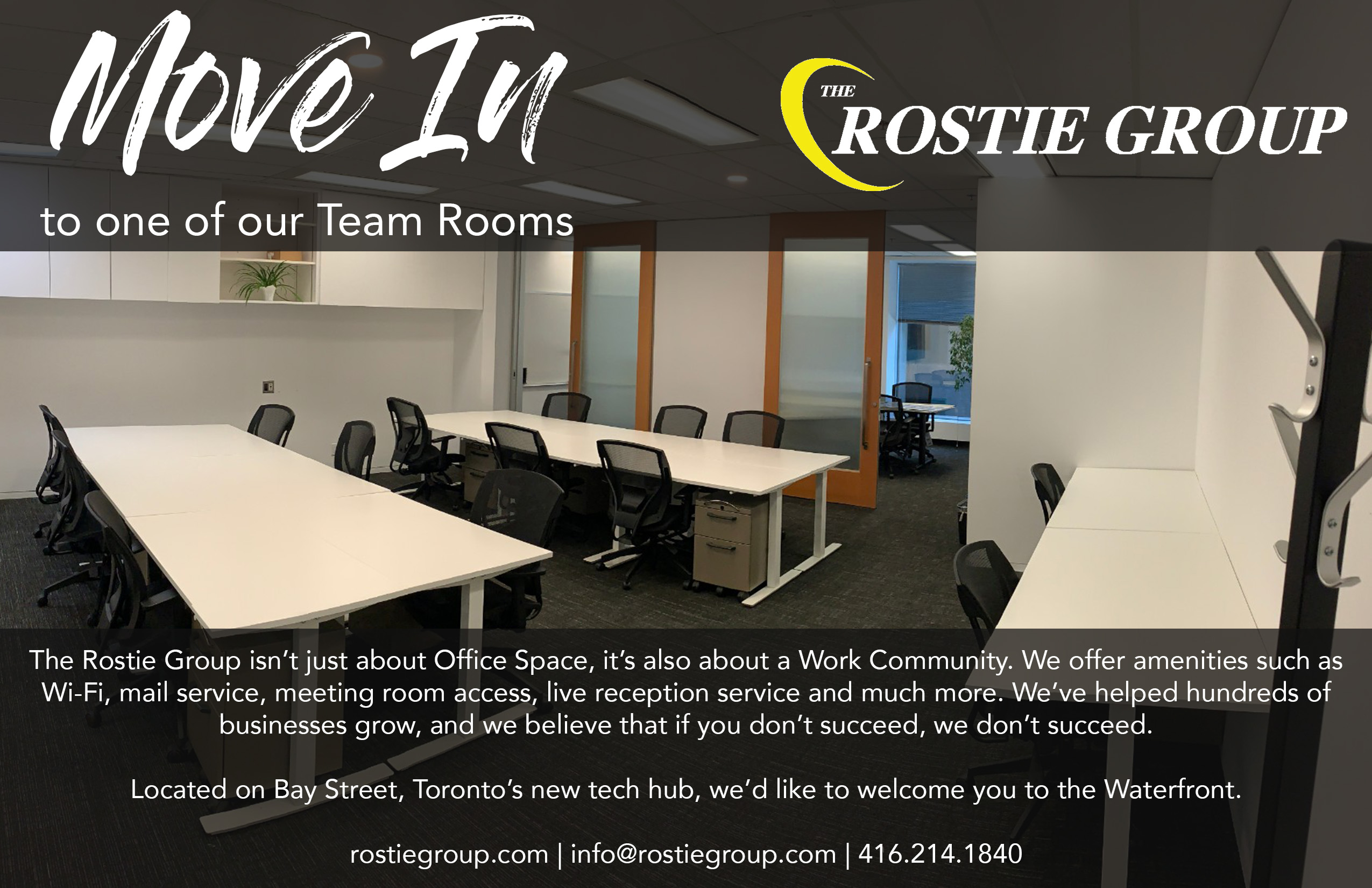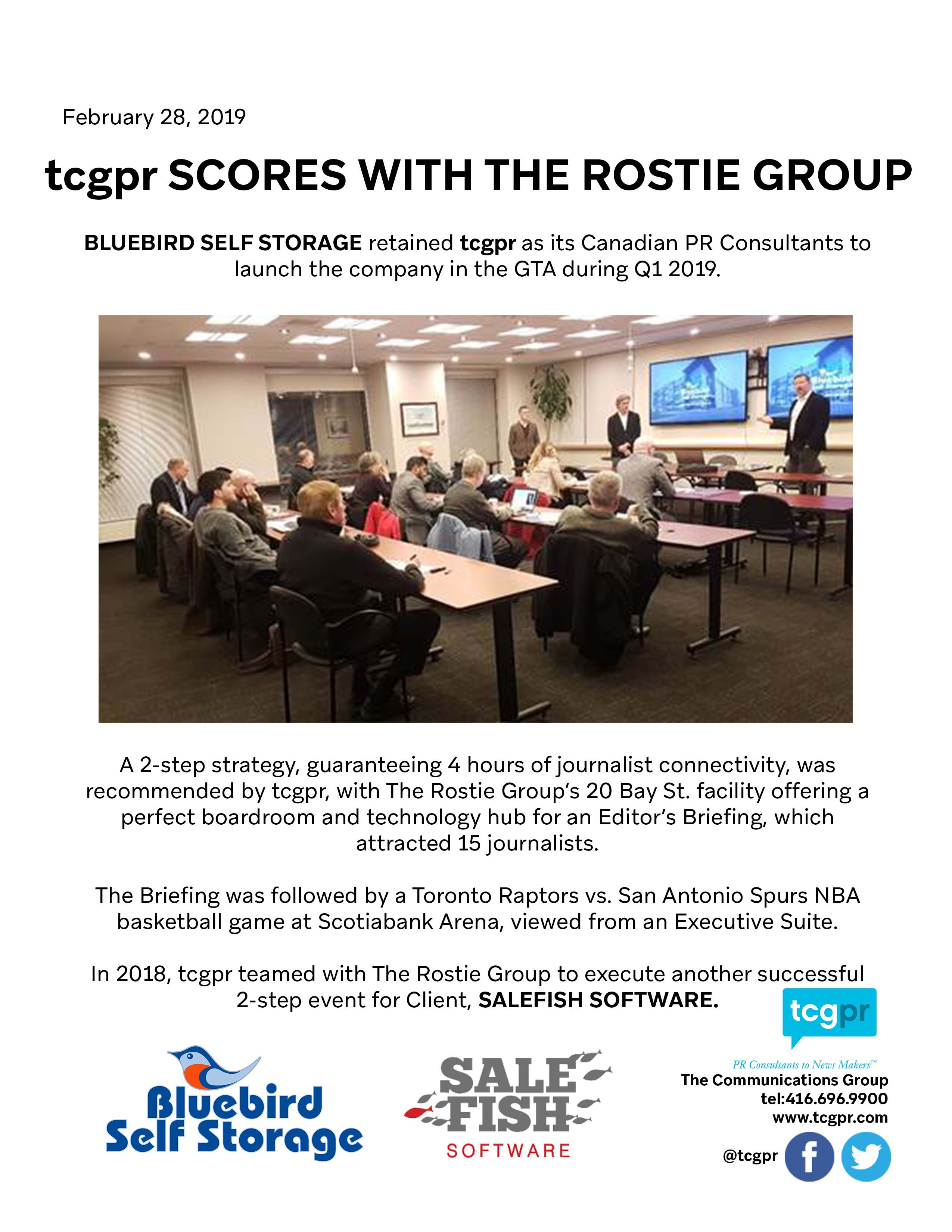Enjoy This Month’s Scoop And Learn About Exciting Events Happening Around Toronto’s Waterfront.
If you would like to advertise in our growing newsletter we are always happy to showcase local companies and community partners. For more information on advertising, email marketing@rostiegroup.com to request a copy of our Media Kit!
You can also read all the editions of The Scoop, on your phone or tablet, through the Google News App. You can even take them with you and read them offline! Just click here to go directly to our Google News feed.
You can also download a PDF version here.
In this Issue




There are many ways that a workplace can be disconnected, leading to inefficiency. A business that tends to overlook the importance of communication in the workplace is most likely unsuccessful. In order to maintain a stable work environment, coworkers must communicate effectively! This means that those who cannot function as a part of a team will prove detrimental. This skill is especially important nowadays where technology consumes most of our time in the office. Social skills continue to be taken for granted as we find less need for them; however, this should be enough to want to enhance this decreasingly prominent ability.

Listening skills are potentially the hardest to come by in terms of communication skills. This skill requires one to allow another to speak without interruption. Also, while they are speaking, be sure to genuinely pay attention to what they are saying. Do not think of what you are going to say when they are done. This distracts you from getting all of the information from what they said. If you’re lucky, you may be able to catch the gist of what they are saying.

Another skill that is hard to come by is confidence when speaking. There is a fine line between confidence and condescension. You must be comfortable with who you are and project that confidence onto others.
Do not brag, but do not self-deprecate. A confident person will have little to no problem communicating with others.
Confidence typically comes from a lack of concern towards if others do not agree with their character. This skill is very beneficial, as you must be able to do things that make you uncomfortable if you wish to develop as an employee.
Legitimate confidence brings with it a confident tone. A confident tone is simply a means of suggesting that you are sure of yourself and you are a reliable and capable worker. Once more, avoid sounding arrogant. It is one thing to be confident in what you’re saying if you are sure you are correct. It is another thing to ensure others you are right when you are unsure. This is simply stubbornness rather than intelligence. Arrogant people are not particularly smiled upon and tend to create conflict in the work- place.

Many workplaces may experience some form of conflict between two or more employees. This needless rivalry will lead to an array of internal problems. This will do nothing but hinder efficiency in the workplace.Therefore, kindness is a skill that an employee must have if they wish to maintain their success as an employee, or else reap the consequences
It is important to note that remaining friendly, even on days that are not going too well, is a skill that employees should learn to have if they wish to grow. Just because your day is rough, it does not mean you can take it out on others.
The Value of Communication Skills
Think about it this way: everyone has bad days. What makes you believe you can take it out on others, while they keep it to themselves, or at least outside of the workplace? This will have people thinking about you in a negative fashion. You will be recognized as a negative person who always complains. Being isolated like this cannot lead to anything beneficial for the business.

It is important that after listening to someone, you provide your input to the conversation. For example, if someone tells you that there is something troubling them. You can either offer a solution, or at least try and come up with something else that may suffice. This way they will know that you were listening. Not only that, they will know that you genuinely care about what they are saying.
These feelings will reciprocate; therefore, they will then respect what you have to say as well. If all you offer to the conversation is “yeah” or “uh-huh”, then you will seem distracted and not actually paying attention. Contributing to the conversation shows respect and a want to better the business.
by: Nathan Felstead
Meetings & Sales Coordinator
nfelstead@rostiegroup.com
The Concept of the Micro Generation
“Kids grow up so fast these days!” – This sentence is older than the people you hear saying it.
But it’s true. Kids DO grow up fast these days, they

grew up fast in the last generation, grow up faster today, and will probably grow up even faster in the future.
But it’s not physical maturity that I’m talking about: it’s knowledge, skills, information and values.
Those also happen to be the same components of what we colloquially think of as a “generation”. Generation X, Generation Y, and the Millennials (who apparently enjoy killing the canned tuna industry).
But this article is not about the plight of the millennials, how they make less money than the previous generations, and how the essentials of life are more expensive than ever before.
It is about looking into the future, and in particular, how to market to the upcoming generations.
Because the old adage is true: Kids ARE growing up so fast these days. In fact, much faster than expected.
The Micro Generation
To explain the concept of the micro-generation, we’ll have to compare and contrast two generations (as if we weren’t divided enough already). Let’s call these two generations the “facebookers” and the “snapchatters”.
The facebookers are millennials. Born in the early 90s and grew up when the Internet was starting to become a
thing. They saw the rise and fall of AOL, lived through Windows ME, and saw Apple become a powerhouse with the release of the iPod.
The snapchatters… Are also Millennials. Born in the mid 00s, they are the generation who grew up with the iPhone, that saw a world with social media “being a thing” and fortunately never had to live through Windows ME.
If both generations are millennials, then why the difference? What sets them apart?
In my opinion, it has to do with the availability of information, and ease of access to it.
The Internet is pretty Fast and it’s getting Faster (unless you live in Canada)
Internet speed is one of the main reasons for the rise of micro-generations. Afterall, we now have commercial gigabit Internet. That would have been unthought of 30 years ago. (And yes, the 90’s were 30 years ago.)
Not only is speed a factor, but so is ease of access.
Of course Google being a major Internet company has made it faster and easier to find… well, everything. The great ruiner of bar bets and arguments. Just ‘google it’.
The other major emerging trend was the smartphone. Computers in our pockets that put entire data centers of the past to shame, and we use it to look at cat pictures. Truly the future.
But all jokes aside, society and culture grow and thrive on the availability to information. The most notable example, being the printing press.
So ease of accessibility to information is one thing that defines a generation, but what else?
Feed Me (Content) Seymour
Every marketer worth their salt has heard the sentence “content is king”. And its absolutely true.
One of the advantages of the increase in speed of the Internet, is the availability and growth of content.
The same smartphones we use to look at cat pictures have amazing cameras and can easily be used to record and stream anything you want to the world.
So it has all become a bit of a perfect storm where information is easy to find, content is easy to produce, and there is an audience hungry for that content.
It is the speed at which this content is delivered that makes a micro generation. We can correlate the speed at which information can be sought out and delivered, with the speed of development of a generation.

But how are these generations identified? What sets them apart?
Tik Tok on the Snap O’ Clock
Let me introduce you to Tik Tok, formerly Musical.ly. An app that has been known to be frequented by children. It delivers 15 second style videos based on music.
And really, that’s all I know about it. But that’s precisely the thing; this is a Global phenomenon, millions of
people use it. But someone like me, just a few years removed from the demographic, has hardly any information about it.
As a part of my Social Media work, I’ve used Snapchat before. But I don’t use it for my personal life. I’m even removed from THAT demographic. I find Instagram to be the “new hotness” and that’s years old by now. Facebook is positively ancient by today’s standards.
Even this Post may be Too Long for the next Generation
Tl;Dr (Too long, didn’t read)
The availability of information has accelerated the generational cycle. Instead of counting a generation in a traditional time span of roughly 30 years, we should be counting them in 10s, or even 5s.
The most noticeable signs of this are the type of content being consumed, and the platforms being used: Minecraft videos on Youtube have become Fortnite videos, and Instagram and Snapchat are becoming Tik Tok.
Kids are indeed growing fast these days.
by: John Vieira
Marketing Coordinator
jvieira@rostiegroup.com
Getting to Know You
Richard Fernandes
Founder and CEO
The Staffing Exchange Inc.
Where is the most interesting place you’ve ever been?
A monastery in the Himalayas
If you had to eat one thing for every meal for the rest of your life, what would you eat?
Steak or King Crab
What is something you think everyone should do at least once in their lives?
Travel to the furthest place a plane will take you
What song would you sing on karaoke night?
Bachman–Turner Overdrive – Takin’ Care of Business
If you could have dinner with any three people, past or present, who would they be?
Martin Luther King, Kim Jong Un and Queen Elizabeth

If You Build It, They Will Come
It’s 2019 and real estate prices are at an all time high in Canada’s largest market. Space is at a premium and vacancy rates are at an all time low. As per the CP24 article published on January 24th, Toronto’s commercial rental rates have surged to an all time high of $35.37 per square feet.
How does that impact your business?
Well, that depends. One would think it would rely on what stage your business is at. But, this real estate shortage is affecting everyone from start-ups and small business owners all the way up to large corporations, only in different ways.
Start ups are facing one of the most difficult times in history to create a home for themselves in what would be considered a hostile real estate environment. When keeping costs down is at a premium, they are being met with a market that has other intentions in mind. This is surely an obstacle that when developing the next ground breaking idea, certainly wasn’t accounted for.
Small business owners will be in for a rude awakening when their landlord approaches them with the new rental price on their lease renewal.
Large changes will need to be made in order to continue to be not only profitable, but to simply pay the bills and put food on the table for their families. A business that may have had a long history in a particular neighbourhood, may suddenly be replaced by a slew of chain restaurants and coffee shops.
Large corporations, although not feeling the same financial crunch as their smaller counterparts, are facing a different problem. As business continues to push forward, they find themselves hiring more and more people, with no clear cut workplaces for them to operate at. Although the new trend of allowing employees to work from home has become quite popular, there are still industries that rely on having their workforce on-site day in and day out.
So, is there a solution to this growing problem? You could continue to construct more buildings, right?
According to CP24, Toronto had 7.3 million square feet under construction in the fourth quarter of last year, up nearly 1.3 million square feet from the previous quarter.
The problem is that even years from completion, all
7.3 million square feet is already spoken for.
However, there is another solution.
Shared offices seem to be the best option for new businesses, relocating businesses or expanding businesses as they present a fully serviced flexible option for any sized business. Given the shorter term commitments, it’s more likely that availability won’t be at a premium and managing your everyday 9 to 5 is made easier. One’s ability to cut down costs and have a plethora of services at their finger tips is also a large selling point.
For more information about relocating your business to a shared office space at The Rostie Group, please visit www.rostiegroup.com or call (416) 214-1840.
by: Tyler Blackwell
Community Manager, The Rostie Group
tblackwell@rostiegroup.com
416-214-1840
@RostieCommMgr

What’s Happening in Toronto this March and April
Yayoi Kusama’s Infinity Mirrors
March 3 – May 27
Art Gallery of Ontario
Apollo & Night & The Sea Above,
The Sky Below & Paquita
March 20 & 21
Four Seasons Centre for
the Performing Arts
The Last Ship
March 5 – 24
Princess of Wales Theatre
Star Wars: The Empire Strikes Back – In Concert
March 20 – 23
Roy Thomson Hall
Toronto Blue Jays
Home Opener
March 28
Rogers Centre
Wedding at Aulis
March 22 – April 14
50 Tank House Lane
Six Sigma Canada
E: inquiries@sixsigmacanada.net
P: 519-355-5511
L: linkedin.com/company/six-sigma-canada-inc-
tcgpr
P: 416-696-9900
F: @TCGPR
T: @tcgpr













